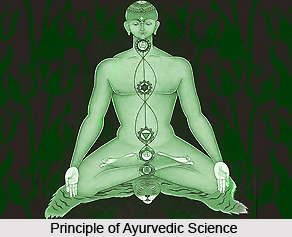 According to Ashtang Ayurveda, seven dhatus or tissues in the human body form the body`s foundation that ensures growth and survival. These dhatus are composed of the five mahabhootas or supreme powers----- earth (prithvi), water (aap), divine fire (tej), air (vayu) and universal space (akash). These seven dhatus are rasa, rakta, mansa, meda, asthi, majja, shukra. Rakta dhatu originates from rasa dhatu, which is at the lowest level in the hierarchical order of dhatus.
According to Ashtang Ayurveda, seven dhatus or tissues in the human body form the body`s foundation that ensures growth and survival. These dhatus are composed of the five mahabhootas or supreme powers----- earth (prithvi), water (aap), divine fire (tej), air (vayu) and universal space (akash). These seven dhatus are rasa, rakta, mansa, meda, asthi, majja, shukra. Rakta dhatu originates from rasa dhatu, which is at the lowest level in the hierarchical order of dhatus.
Rakta or blood may be described as a specialized connective tissue that consists of a liquid intracellular substance known as plasma and formed elements such as the red blood cells (RBC), the white blood cells (WBC) and the platelets suspended in the plasma. The first life on earth was unicellular and aquatic. The body constitution was such that seawater could easily flow in and out providing nutrients and driving out waste products. But with the advent of the multicellular organisms, a closed circulatory system evolved because the open circulatory system failed to provide nutrition to all the cells. The seawater, which used to remain outside the body, became entrapped in the body, and underwent a series of profound physiological changes in the course of evolution to be eventually transformed into what we now call rakta.
Rakta has a wide range of functions. It carries oxygen from the lungs to the tissues and carbon dioxide from the tissues to the lungs. Blood absorbs the digested food materials from the intestine and carries them to the tissue cells for utilisation. Moreover, the nutritive materials are carried from one place of the body to another.
Rakta is a vehicle through which the hormones, the vitamins, and other essential chemicals are brought to their places of activity. Other functions of blood include drainage of waste products, protection against haemorrhage through the property of coagulation, maintenance of water balance, acid- base equilibrium, ion balance, and regulation of body temperature and pressure. In addition to these, blood acts as a great defensive mechanism by producing antibodies and engulfing bacteria and foreign particles.
Each RBC component of rakta is a circular biconcave disc without a nucleus. Each cell is composed of a colourless envelope enclosing semi- liquid material, 65 percent water, and 35 percent solids of which 33 percent is haemoglobin (red pigment of blood comprising proteins) bound to 2 percent proteins.
The normal average RBC count in adult male is taken as 5 million and in female 4.5 million per cubic millimetre. In infants the count is 6 to 7 million, whereas in foetus the number is around 7.8 million. RBC carries oxygen and carbon dioxide. It also helps in maintenance of acid- base balance, ion balance and viscosity of blood. Various pigments like bilirubin and biliverdin are derived from haemoglobin after the disintegration of the red blood cells. The average life span of RBC is about 120 days in man.
The WBCs are an important variety of cells in rakta. They do not contain haemoglobin, are larger in size than the red blood cells, and are nucleated living cells. The white blood cells are rich in nucleoprotein and also contain substances like lipids, glycogen, cholesterol, ascorbic acid and a variety of enzymes. The total number of white blood cells is 6000 to 8000 per cubic millimetres. There are different types of white blood cells with varied functions. Their functions include engulfing foreign particles, formation of antibodies and helping in the process of repair in case of injuries.
Platelets of rakta are non- nucleated round or oval, biconvex discs having various sizes and covered by unit membrane. Probably, platelets contain protein and a considerable amount of a substance called phospholipid. The average number of platelets present per cubic millimetre of blood is about 250000 to 450000. The primary function of platelets is to initiate blood clotting.
Thus we see that rakta serves those purposes in a multicellular organism which seawater performed in the primitive unicellular organisms. Rakta along with rasa, form a transport system within the body that ensures proper distribution of nutrients from head to toe.





